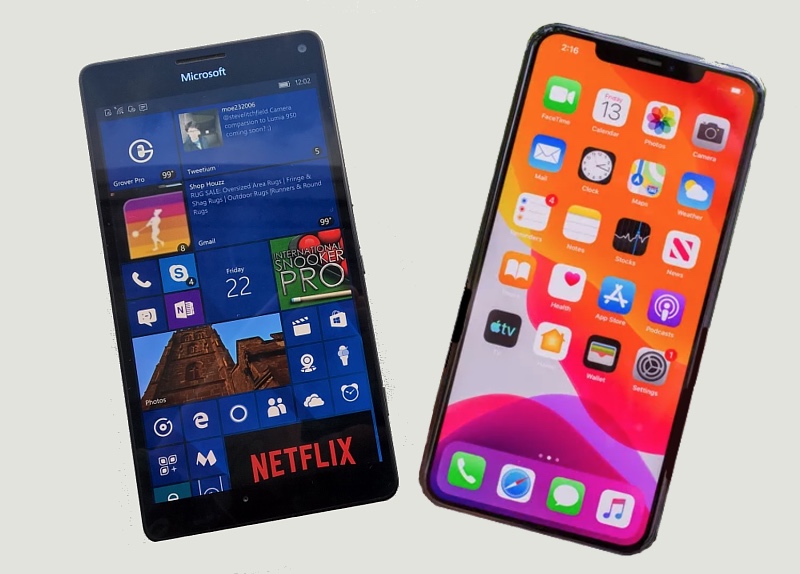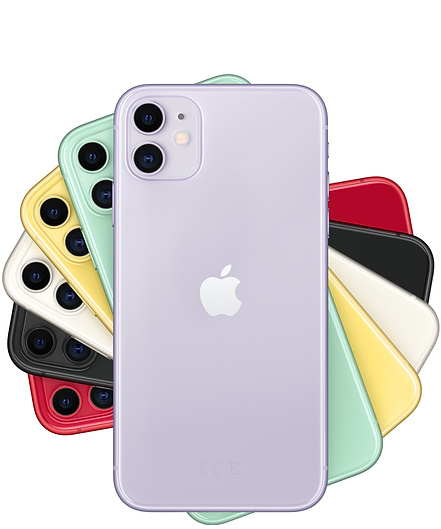
Although there's a little life left in Windows 10 Mobile in terms of updates and support, new hardware is non-existent, plus repairs and spares for older hardware are heading the same way - so it makes sense for everyone to be aware of the best of the rest from other platforms. I'll cover Android again in the future, but for now let's look at the best of iOS for a vaguely sensible price. Apple's OS does resemble Windows Phone in many ways in that it's all locked down and every application is sand-boxed. Apart from the lack of a live tiles equivalent and the lack of a user file system (however trivial), there's more in common than you might think.
So I'm comparing here to the new iPhone 11, available tomorrow from £729 inc VAT in the UK. Imaging is better than ever, audio is better than ever, battery life knocks it out of the park, and it even comes in a Lumia-esque range of colours!

As usual, I've shaded in green an obvious 'win' for either device. Any row where a winner would be totally subjective is left uncoloured. Or, where all devices are utterly excellent but in different ways, I've given each a 'green'(!)
[By the way, if you're viewing this feature on a phone then the table may well cause you problems. Try viewing in landscape mode? Failing that, go view this on a laptop or tablet!]
| Microsoft Lumia 950 XL | Apple iPhone 11 | |
| Date first available | November 2015 (can you believe that the 950 XL is now 4 years old??) | September 2019 |
| Current price, availability | No longer officially for sale, though it's often on clearance prices if you're lucky and at outrageous profiteering prices due to rarity (if you're not!) | £729, for the 64GB model from Apple. Despite this not being a trivial amount, at least it's for sale and with full hardware support. |
| Dimensions, form factor, weight |
152 x 78 x 8mm, plastic chassis and replaceable backs (plastic/leather/wood etc, from Mozo, as modelled here!), 165g, bezels are comparatively small |
151 x 76 x 8mm, aluminium chassis with glass front and back, 194g, similar dimensions to the Lumia but substantially heavier, partly down to the use of metal, partly through the sheer amount of componentry. |
| Durability | No specific durability metrics, though the fact that the back comes off will help enormously for water damage, i.e. taking out battery and cards immediately, drying out the internals, even unscrewing the motherboard from the guts of the phone. I'm old-school here! All damage to the back or corners is trivial through replacement of the rear, but the screen's exposed, of course. | IP68 for liquid and dust, but a case will be required for drop protection, with glass on both sides, however toughened it is... |
| Operating system, interface | Windows 10 Mobile, (dismissable) virtual controls, as needed, now officially updated to W10 Fall Creators Update (Redstone 3, Autumn 2017) | iOS 13, gesture-based home control, largely restricted to portrait use in general apps |
| Display |
5.7" AMOLED (1440p at 16:9 aspect ratio, matching most video media), Gorilla Glass 4, ClearBlack Display polarisers help with outdoor contrast, excellent viewing angles. Glance screen available (in various colours) for always-on time, day and notification icons, plus some detailed info from a specified app. Screen area is approximately 90 cm2 |
6.1" 828p resolution at 19.5:9 aspect ratio, IPS LCD display, 'ion-strengthened glass', excellent viewing angles, though the display has the famous 'notch' cut out at the top and this affects many applications aesthetically, for better or worse(!) No 'glance'/always on display capbility, sadly. Screen area is approximately 90 cm2, the exact same area as the Lumia |
| Connectivity |
LTE, NFC (all uses), Wi-Fi b/g/n/ac, integral wifi tethering, Bluetooth 4.2 (all uses). Continuum connectivity to use a wide range of first and third party UWP apps on external displays as secondary screen, independent of the phone display |
LTE, NFC (but only for Apple Pay), Wi-Fi b/g/n/ac, Bluetooth 5.0 (again restricted to Apple-approved comms), integral wifi tethering |
| Processor, performance | Snapdragon 810 chipset with 'liquid cooling', 3GB RAM, faster than it's ever been now on the Fall Creators Update though still slower for almost everything than on the iPhone. Multi tasking and app resumption is excellent though, at least with all the modern UWP apps |
Apple A13 Bionic chipset, 4GB RAM, very fast, Apple always do an incredible job in terms of TLC and optimisation. |
| Capacity | 32GB internal storage, expandable via microSD to extra 256GB | 64GB internal storage (in the variant being considered, no expansion, optional 128GB or 256GB internal at extra cost) |
| Imaging (stills) |
20MP PureView f/1.9 1/2.4" BSI sensor, Phase Detection auto-focus, dedicated camera shutter button and launch key, genuine 2x lossless digital zoom (in 8MP oversampled mode), OIS. 'Rich Capture' produces customisable HDR shots and 'dynamic flash', with triple LED illumination. Outstanding shots in most light conditions, with just focussing issues in low light as an Achilles heel. 5MP front camera |
12 MP, f/1.8, 1/2.55", main camera with PDAF, OIS, plus 12 MP, f/2.4, wide angle. Smart HDR processing works wonders, apparently (watch this space for some iPhone 11 imaging shootouts!), plus an incredible Night mode implementation that I'll be testing very soon. 12MP front camera, f/2.2 |
| Imaging (video) | Up to 4K, optically (and optionally digitally) stabilised, with 'Best photo' 8MP grabbing built-in, plus Rich Recording and HAAC microphones for high quality, gig-level stereo capture. | Up to 4K video capture on normal and wide angle lenses, with EIS and OIS, high quality stereo capture. |
| Music and Multimedia (speakers) |
Weedy mono speaker, piercing but lacking in bass and depth, though you can trade volume for fidelity in a simple tweak. | Stereo speakers, the right hand one outputting through the phone's bottom. Decent volume from the pair, and well tuned. |
| Music (headphones) |
3.5mm headphone jack, A2DP+AptX, so great wired and wireless headphone audio too. | Infamously, no headphone jack, so you have to go Bluetooth or buy a Lightning to 3.5mm DAC/adapter. |
| Navigation |
Windows 10 Maps is now pretty mature and impressive, especially once you've learned the live traffic routine trick! Offline maps save a lot of data bandwidth for those on tight contracts or pay-as-you-go, and these get the win here. |
Apple Maps uses live traffic and (now) its own map data. There's no official offline maps facility, though this is said to be coming. |
| Cortana/Voice | Cortana is now mature and well integrated, though some functionality has been falling away, e.g. recognising ambient music, plus there are reliability concerns under Windows 10 Mobile. | Apple's Siri is sassy and usually helpful. It's been improving slowly and is certainly better than Cortana now, but Google's effort with Assistant currently leads the pack in the industry. |
| Battery, life | Removable 3300mAh battery, and the ability to change cells gets brownie points here, plus USB Type C Power Delivery (up to 3A) and Qi wireless charging built-in. |
Sealed 3046mAh battery, easily gets through a day (apparently), thanks to the low power cores in the A13 chipset plus iOS's good standby characteristics. Charging is via Lightning port and nominally only 1A out of the box, though the 3A charger supplied with the 'Pro' models should also work, plus there's now Qi wireless charging too. |
| Cloud aids | Windows Photos syncs across all signed-in devices, subject to your OneDrive tariff (stingy, unless you have Office 365), should you have thousands of images in the system. Plus Windows 10 backs all your media, application data and settings to a separate backup folder system, tariff-free on OneDrive, for easy restoration on a new or factory reset phone. | Recent photos auto-sync to iCloud, backups in general ditto, so if you want to, there's a complete image of your phone ready to restore at any point. Apple do this very well, as anyone who's had to restore an iPhone will have found. Most iPhone users will testify that some iCloud subscription payment is quickly necessary, so factor in a cloud storage plan. |
| Biometrics | Iris recognition ('Windows Hello') works well unless you wear varifocals(!), but takes a couple of seconds (including an animation!) in real world use. There's also no official way of paying in shops using this, at least not in most of the world. | Face ID, using a laser-lit front facing camera is the only authorisation method here for unlocking the phone and for 'Apple Pay'. It works... most of the time. More of the time than the Lumia's iris recognition anyway! |
| Applications and ecosystem | Windows 10 Mobile has most (though not all) mainstream apps and services covered. Often third party clients are involved, mind you, there are companies who hate Microsoft so much that they simply refuse to write for Windows, it seems. And 'long tail' niche/boutique apps are hard to find for real world companies and shops. | Fully covered, from A-Z, of course. Any application of any significance in the mobile world is available for iOS. Including most of the Microsoft core applications, like Outlook and Office. |
| Upgrades and future | Windows 10 Mobile will be updated through the end of 2019 - after that the OS will be useable but with more and more service caveats applying. | Apple push system and security updates regularly - the iPhone 11 should be updated until at least the end of 2021. |
Verdict
Wait for it... Adding up the green 'wins' (for fun?!) gives a score draw, at 9 apiece. This is, I think, the first time I've scored an iPhone level with a Lumia and marks the gradual falling into lack of support for the latter, in terms of both hardware and software, along with significant improvements on the iPhone front, here in terms of value, imaging and battery.
The usual caveats apply about totally different ecosystems, and going where the services and apps you need live - you could argue that the 'Applications and ecosystem' row should have double or triple weighting, for example! Plus several of my scorings can be argued either way, such as me rating the 950 XL as (theoretically) more durable and (self?) repairable than the iPhone, yet without any waterproofing at all.
But my headline is appropriate, I think. A line has been crossed. With Apple dropping the price for the 'value' iPhone and simultaneously making it far more capable, we have reached the point (or will tomorrow, as I write this) where I'm happy for the first time to recommend an Apple smartphone as a direct replacement for a Lumia 950.
Your comments welcome.

(photo from CNET, see their galleries. Here we see the translucent wide-preview in the camera UI and also the Night Mode in the viewfinder)
